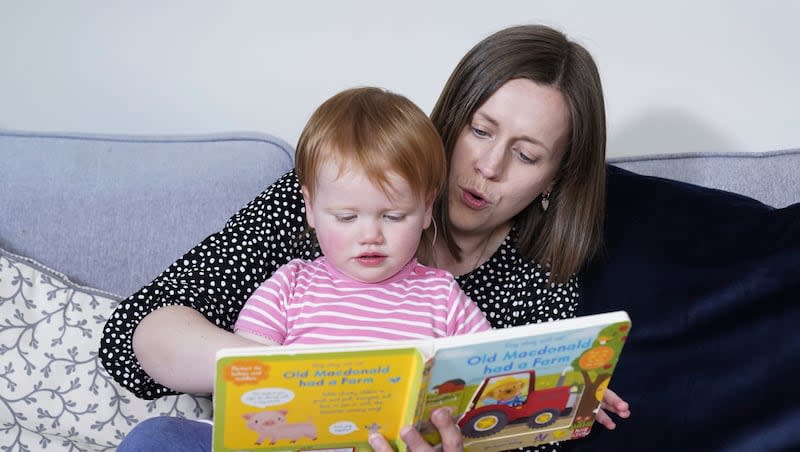Baby born deaf hears after unique gene therapy

Opal Sandy, now 18 months old, was completely deaf at birth due to a rare genetic condition called auditory neuropathy. But within four weeks of receiving a gene therapy infusion in her right ear as part of an international clinical trial, she responded to sound.
That’s according to a statement from the National Health Service and Cambridge University Trust in the U.K.
The girl, from Oxfordshire, received the gene therapy when she was 11 months old, the surgery performed at Addenbrooke’s Hospital in Cambridge, officials reported. She is the first British patient and the youngest child to receive the treatment. According to the report, “Clinicians noticed continuous improvement in Opal’s hearing in the weeks afterwards and at 25 weeks confirmed close to normal hearing levels for soft sounds, such as whispering, in her treated ear.”
She now says common words like “Dada” and “bye-bye” and the result of her progress at 24 weeks is being presented to the American Society of Gene and Cell Therapy in Baltimore this week.
Impact of delayed diagnosis
The clinical trial, called the CHORD trial, is sponsored by Regeneron, which is enrolling participants in the U.S., the U.K. and Spain.
Per the release, patients in the first phase get a low dose of the gene therapy in one ear. In the second phase, it’s expected a higher dose in one ear only will be used, after safety is proven by the starter dose. The third phase will include gene therapy in both ears with the dose to be based on findings in the previous two phases. Patients will be followed for five years to see how well they adapt and learn to understand speech.
An estimated 20,000 people in Europe have a problem with a single gene, called OTOF, which produces the protein otoferlin, which allows the hair cells in the inner part of the ear to communicate with a nerve that communicates sound. There are other causes for auditory neuropathy, but the clinical trial, which started last May, targets this specific issue.
“These results are spectacular and better than I expected,” said Manohar Bance, an ear surgeon at Cambridge University Hospitals NHS Foundation Trust and the co-senior investigator of the trial, in the news release.
He said that there’s a “short time frame to intervene because of the rapid pace of brain development at this age,” but often the diagnosis is missed because at newborn screening the hair cells appear to work, even though they don’t talk to the nerve. Hearing loss may not be found until a child does not begin to hear as early as expected. Bance said that families become confused and the child falls behind when the diagnosis is not found in a timely manner.
The child was “given an infusion containing a harmless virus” that carried a working copy of the OTOF gene and was injected into her cochlea during an operation while she was under general anesthesia. While gene therapy was placed in her right ear, she received a cochlear implant — the standard of care for this condition — in her left ear.
BBC reported that “rather than making sound louder, like a hearing aid, it gives the “sensation” of hearing by directly stimulating the auditory nerve that communicates with the brain, bypassing the damaged sound-sensing hair cells in a part of the inner ear known as the cochlea.”
The news release quoted the child’s dad, James Sandy: “It was our ultimate goal for Opal to hear all the speech sounds. It’s already making a difference in our day-to-day lives, like at bath time or swimming, when Opal can’t wear her cochlear implant. We feel so proud to have contributed to such pivotal findings, which will hopefully help other children like Opal and their families in the future.”
“It was really scary” to let their child be the first to test the treatment, “but I think we’ve been given this unique opportunity,” the girl’s mother, Jo Sandy, told BBC.
Other hearing approaches
Per The Washington Post, “Other clinical trials looking into gene therapies as a way to restore hearing in children with deafness caused by OTOF gene variations are also underway elsewhere in the world. Last year, an 11-year-old boy, Aissam Dam, received treatment in a separate gene therapy trial at the Children’s Hospital of Philadelphia. China is also conducting a number of trials.”
In January, Harvard Gazette reported on an experimental gene therapy to correct the same OTOF gene mutation that affected Opal. Five children in Fudan, China, received gene therapy in a study being conducted by Fudan University’s Eye and ENT Hospital and Harvard researchers at Massachusetts Eye and Ear. The children are ages 1 to 7.
The results, published in The Lancet, found five of the six children showed hearing improvement over the 26-week trial. For four, the outcomes were “robust.”
The article quoted Zheng-Yi Chen, co-senior author, who said that more than 1.5 billion people worldwide have hearing loss, including roughly 30 millions cases of genetic hearing loss in children.

